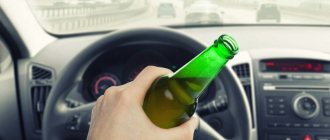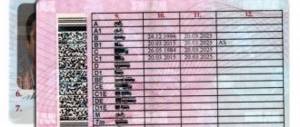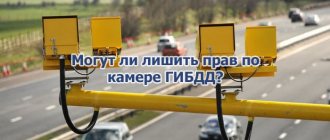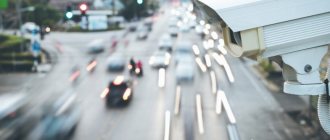If a person has vision problems, then he is required to drive a car only with glasses or contact lenses. This is a guarantee of his safety and the safety of other road users. A special note is made about this fact on the driver’s license. The document states that glasses are required for the driver. If the subject violates these rules and neglects safety, then he must pay a monetary penalty. And further about what its size is and what responsibility is for such actions.
Marking points on your license: what is it and what does it oblige you to?
Current legislation does not in any way restrict drivers who even have health problems. In order not to infringe on the rights of people with poor vision, the ability of such subjects to drive a vehicle is provided. Logically, if they can perform other types of work wearing glasses or lenses, then why can’t they drive?
But the presence of vision problems obliges the subject to drive with special equipment - glasses or contacts.
And there is even a special note about this on the driver’s license. The note may have the following wording: “Glasses/lenses are required.” This means that the driver has a medical obligation to wear glasses or contact lenses while driving a vehicle. If he does not want or cannot for some reason put on glasses, then he cannot sit behind the wheel. It's simple. Interesting information : such a note as “Glasses-lenses are required” exists on driver’s licenses that were issued before 2011. Consequently, the maximum period for their circulation is until 2021. We remember that the document has a validity period of 10 years. After this period it must be replaced.
Medical examination for vision
The check includes diagnosing:
- visual acuity;
- color perception;
- viewing width;
- ophthalmological diseases.
Visual acuity
Vision is diagnosed using a special table by Sivtsev or Golovin. If the driver uses glasses or contact lenses, their vision is checked directly while wearing them.
Restrictions on obtaining driver's licenses
Non-professionals of categories A and B (motorcycle and passenger transport):
- vision for a good eye – not less than 0.6; for the second – no less than 0.2 (no matter which eye sees better);
- if one of the eyes is blind, the other must have a vision level of at least 0.8 with any correction;
- at least one month after eye refractive surgery.
Professionals of categories A and B and drivers of categories C, D, E, Tm, Tb (various types of trucks, buses, trams and trolleybuses):
- vision of the first eye – not less than 0.8; the second – 0.4 (and if both eyes are open, vision should be at least 0.7);
- Corrective agents cannot be used more than plus or minus 8.0 diopters, and the difference between the eyes can be no more than 3.0 diopters;
- for astigmatism - the sum of the cylinder and sphere should be no more than 8.0 diopters, and between the eyes - 3.0 diopters.
- if one eye is blind, the other must have visual acuity of at least 0.8 without correction.
- the absence of chronic eye diseases that interfere with the normal functioning of the visual apparatus and cannot be treated: cuts in the muscles of the eyelids, diplopia, paralytic strabismus, optic nerve paralysis, retinal detachment, glaucoma and others (after a successful operation to eliminate them, licenses can be issued based on the results of an individual examination );
- absence of spontaneous nystagmus (position of the eyeballs seventy degrees from the correct one).
Level of color perception
To obtain a driving license, you must also undergo a color vision test. The driver's perception of color has not previously been a reason for restrictions. But later they found out that if the driver incorrectly distinguishes the colors of the traffic light, this can lead to tragic consequences. After this, people with color vision disorders were prohibited from professionally driving any vehicles.
Color perception is checked using Rabkin’s polychromatic tables:
It consists of sheets on which different elements are depicted, usually numbers, of the same brightness, but different in color. To a person with disabilities, it seems that the picture is entirely one color, but a healthy person can distinguish elements of different colors. The more images are recognized incorrectly, the stronger the level of anomaly. Color blindness is incurable and cannot be corrected.
Field of View Width
To obtain a driver's license, the candidate's viewing width is also checked. It should not be limited to more than twenty degrees, either vertically or horizontally.
Like color vision impairment, vision loss cannot be corrected with lenses or glasses.
Other obstacles and tips
What other factors may become an obstacle to obtaining rights? Candidates are required to undergo surgical treatment for:
- persistent changes in the mucous membranes of the eyes and extraocular muscles;
- pathologies of the lacrimal sac;
- diplopia (i.e., double objects in the eyes) due to strabismus;
- retinal detachment;
- optic nerve atrophy;
- glaucoma.
Visual restrictions for category B drivers
About (GCL)
Regarding the new rights that are issued according to international standards, they have a completely different mark. At the same time, the meaning of this mark is similar. But it is called “GCL”. This abbreviation literally stands for glasses or contact lenses. From English this translates as glasses or contact lenses. This mark also indicates that the subject has some visual impairment and should operate the vehicle with glasses or contacts only.
Both marks are similar in essence and can be used in both national and international licenses.
What other indicators are taken into account during a vision test?
No less important is the color perception indicator.
To check it, the Rabkin table is used. If, based on the results of the test, it turns out that the driver has impaired color vision for green and red, the issuance of a driver's license will be denied, since it is believed that the driver will not be able to distinguish between the colors of the traffic light.
Despite the fact that in practice this defect does not interfere with distinguishing traffic lights, because the driver remembers the switching sequence, obtaining a license with such a deviation is prohibited. In some countries, to solve this problem, they plan to use different forms of lamps for traffic lights to eliminate the possibility of confusing signals for drivers with such a defect.
Categories “B” and “C” can be opened with minor deviations, provided that the applicant distinguishes the colors of the traffic light.
Another indicator of normal vision function that gives permission to drive is horizons. Narrowed vision of the eyes is usually a symptom of certain diseases. If it is present, the view is extremely narrowed. According to standard indicators, it should not be less than 20 degrees. This defect cannot be corrected with the help of corrective devices, just like color blindness. Therefore, if the indicators are exceeded, the subject will not receive permission to drive.
Note: where should it be?
Proper and correct indication of visual limitations is Section 14 of a driver’s license. This is not any other section, incl. and not section 12, as most people think. For example, section 12 indicates health restrictions of a more global nature.
But this concerns new rights. The old rights do not have such sections. In this case, the note is indicated where space is provided for special notes. This can be either on the front of the license or on the back of the document.
Requirements for photographs for rights in 2021
Now photographs are taken according to the established procedure. Let's look at what the photo requirements for a driver's license are in 2021. If you take photos in a photo studio , then the specialist must take into account the order of the Ministry of Internal Affairs of the Russian Federation No. 206 :
- overall size;
- scale of the face in the photo;
- size of fields;
- background color.
The photo on the right implies the placement of the face strictly in the center of the frame. The gaze must be directed towards the lens; smiling and other changes in facial features are not allowed. Also, it is forbidden to squint your eyes when photographing documents , and it is also forbidden to be photographed wearing any hats or sunglasses .
As for the basic requirements for a driver's license photo, the size of the driver's license photo must be 3x4 centimeters . For a long time now, a white corner for printing has not been made on such a photograph, either on the right side or on the left. It is advisable to take photographs for your license in formal clothing without an open neckline. Also, in such a photograph both the forehead and chin should be clearly visible . Therefore, it is recommended to get your hairstyle right before taking your driver's license photo.
To obtain a driver's license, you must take two good quality photographs. Namely, the contrast of the image should be average. If there are shadows on them or they are too light or too dark, the traffic police may simply not accept such photographs.
If previously the background of the photo was white, now the main background of the photo on the rights is red . Also, photographs for a driver's license must be in color. Black and white version is not allowed here.
There are no glasses or lenses, but there is a note on the license: what is the fine?
An interesting situation with the responsibility of drivers who are required to drive a car with glasses or lenses. If you look at the Administrative Code, there are no types of liability for such actions. Theoretically, the subject could operate the car without glasses and suffer no consequences. But the practice of 2021 shows that fines are still applied. And the amount of the penalty is not small. It can even reach 15,000 rubles. The minimum penalty is 5,000 rubles.
And such situations are quite controversial. In fact, inspectors apply rules that indicate a ban on driving a vehicle at all. But it is not so. And this is also proven by judicial practice, when judges’ decisions are made in favor of violators.
But there are other court verdicts that indicate the following: if there is a note on the license, then the driver is required to wear glasses or contacts. If they are not there, then such control of the vehicle is equivalent to driving without a license. And here there is a legislative basis for such a norm.
According to the law, a driver cannot drive a car in three cases:
- the subject's rights were confiscated;
- the driver's license has expired;
- There are medical contraindications/restrictions.
And the third option is precisely related to the GCL mark. But here we also need to make a distinction:
- medical contraindications – if present, the subject is generally prohibited from driving the vehicle;
- medical restrictions are the inability to drive specific types of vehicles or drive any type of car under specific conditions.
So, visual impairment is equated precisely to medical contraindications. And therefore it is punishable by a fine. Although in fact, poor vision is not always a contraindication. The issue is ambiguous and remains at the discretion of the judges. But if you appeal with the same Code of Administrative Offenses, then the amount of the penalty should be 500 rubles, but not 15,000.
Full medical examination procedure
The candidate can undergo the medical examinations necessary for admission to take a training course at a driving school at any of the specialized institutions. The only important factor is the fact that the clinic must have a state certificate for qualified medical examinations.
If you have serious chronic diseases or pathologies, you must take with you a card containing medical records and extracts from the medical history. A detailed study of this information will allow specialists to make a reasoned and most correct conclusion regarding the ability to drive a car.
Basically, the price depends on the region and level of the hospital you decide to go to.
Depending on the results of the inspection, a certificate for obtaining a license to drive a personal vehicle is issued for the following period:
- 3 years - for drivers of personal cars without any health impairments.
- 2 years - for people who plan to work as drivers of freight or passenger transport.
- 1 year - for persons applying for a license who have not reached 20 years of age or are over 50 years of age.
- If an applicant driver exhibits deviations from normal health indicators, then a license is also issued for a period of no more than 1 year.
The fact of presence of lenses: is it worth proving to the inspector or not?
Let's say there is a note on your driver's license that you need to use glasses or contacts. No one has the right to force a person to use a specific frame; he can easily use lenses. And here you need to understand: if an inspector stops a subject with lenses, then he cannot predict in any way that he has a special mark on his license. The lenses are not visually detected.
Secondly, it is necessary to justify the very fact of the stop; for this there must be other violations. If they are not there and the driver asks the person to present a license that has a mark on it, and then begins to determine the presence of lenses, then this is a rather subjective attitude.
And most importantly: the inspector is obliged to prove the guilt of the subject before drawing up a protocol on administrative punishment. That is, he must present facts indicating the absence of lenses. It is impossible to do this. And ideally, a penalty cannot be issued for such a violation. In fact, first protocols are drawn up and penalties are issued, and then decisions are appealed in court.
Requirements for international rights photographs
There are differences for driving abroad. They also apply to photographs. Exactly what photographs are needed for an international driver’s license are specified in Appendix No. 2 of Order No. 206 of the Ministry of Internal Affairs of the Russian Federation .
In a specially designated place (“ Photographie ”), a photograph of the owner measuring 35 x 45 mm , made on matte photographic paper in black and white or color, is pasted. The photograph must have a clear image of the face strictly from the front without headdress. It is permitted to submit photographs wearing hats that do not hide the oval of the face by citizens whose religious beliefs do not allow them to appear in front of strangers without hats. For citizens who constantly wear glasses, it is mandatory to take photographs with glasses without tinted lenses. Under the photograph, in place of a special mark (“ Signature du titulaire ”), the owner’s personal signature is affixed with special ink or black paste.
The entered entries and the pasted photograph are certified by the round seal of the State Traffic Inspectorate, used for international driver's licenses.
A photo to replace a driver’s license is also no longer on the list of required documents for submission to the MREO. After all, police officers will do it themselves right on the spot. That is, now there is no such need to go take a photo in advance and then go with it to the traffic police. Submit all the documents, come to the traffic police, and they will take a photo for you to replace your old license with a new one right on the spot.
How is it possible to prove the presence of lenses?
If you are stopped by an inspector and you are required to wear glasses or contacts, then you can simply say that you are now wearing contacts. There is not a single norm that would oblige a subject to wear only glasses.
Another thing is that the inspector may not believe it. But this is not enough for administrative responsibility. First you need to undergo a medical examination and receive the results of the examination. To do this, the traffic police officer must offer you to undergo such an analysis. And when there is a result, make a decision on punishment (if necessary).
Commission vision testing for future drivers
A variety of health checks, including eye assessments, are carried out for drivers in order to ensure safety for all participants while driving on roads. Good vision helps to drive a car in strict accordance with the rules. If there are problems with the condition of the eyes, the enterprise becomes simply dangerous - this increases the likelihood of emergency situations and significantly increases the risk of injury.
If vision does not correspond to the norm, drivers have an increased chance of causing an accident or causing one by incorrectly assessing the situation on the road. Therefore, it is necessary to be attentive to the health of the visual organs if a person wants to drive independently. During a medical examination by an ophthalmologist, the following possibilities are assessed:
- Degree of color sensations;
- Line of sight;
- Visual acuity.
To correctly determine visual acuity, the Sivtsev table is used. It uses the Russian alphabet; on the poster the signs are placed so that in each line their size is slightly smaller. The subject is placed at some distance in front of the table, from where he will have to read the letters indicated by the specialist. Visual acuity will be determined by which of the rows he can accurately identify the letters.
To obtain results during eye tests, the Golovin table can also be used - it uses rings arranged in 12 rows and gradually decreasing in size. The test is carried out as follows: the specialist asks the subject to name some signs, which he himself will point out. When working with such a table, the candidate driver will have to indicate on which side of the ring the gap is located.
If there are problems in this area, some even try to memorize the vision table for drivers. This is not difficult to do - it uses only a few letters of the Russian alphabet. But the deception will most likely be unraveled. In addition, if incorrect information is provided as a result of an erroneous inspection, many people experience problems during subsequent inspections.
If a test is carried out by an eye doctor for a driver's commission, and the subject wears lenses or glasses, he will have to read the letters from the material without removing them. The certificate issued based on the results will indicate that the vision indicators were recorded for the person while using corrective devices. It must be borne in mind that obtaining a vision permit for drivers wearing glasses or lenses obliges them to drive a car only with the use of corrective elements. If you don't have them, you can get a fine for a considerable amount - driving without glasses for people with vision problems is almost equivalent to driving without a driver's license.
Appealing an issued monetary penalty
Everyone has the right to appeal. But here we need to evaluate the real facts. If you are required to drive with glasses or contacts, but for some reason you did not do this, which is confirmed by a medical examination, then filing a complaint is pointless. The court's decision will be made similar to the inspector's decision.
If you did not violate, but objectively were wearing lenses, then the statement of claim makes sense. As a rule, if there is no medical examination, but only an inspector’s report, the court goes to the meeting of the driver. It wouldn’t hurt to record a conversation with a traffic police officer on camera.
Anti-lights and glasses for driving at night
The name speaks for itself: such models protect the eyes from the bright light of the headlights of oncoming cars, the light of billboards, and streetlights. That is, unlike polarized models, which are mainly used during the day in bright light, “anti-headlights,” on the contrary, are needed in twilight and poor lighting conditions. As a rule, they have yellow or orange lenses and a mirror coating on the top, which reduces the luminous flux. “Anti-lights” are capable of blocking the intense light of halogen, xenon, and incandescent lamps, as well as increasing image contrast.
If you often drive at night, in foggy conditions, or in poor visibility, then it is advisable for you to choose special glasses for driving at night. In some respects they are similar to “anti-headlights”, but may also have additional advantages.
Good driver's glasses for night driving absorb part of the violet-blue region of the spectrum and improve light transmission in the yellow-green zone, due to which the contours of objects become clearer and clearly visible even in the dark. By enhancing the brightness of the image, such models help relieve fatigue and drowsiness. A feature of glasses for night driving is impaired color rendition, but most drivers adapt to this fairly quickly.
What about medical vision limitations in 2021?
Everything is clear here. There is an adopted Government Resolution No. 1604, which sets the limits of vision:
- In the worst visible eye, vision should be at least 0.2;
- On the best eye - not lower than 0.6.
The norm is fulfilled for both eyes at once. If at least one condition is not met, therefore, the subject cannot control the vehicle.
It is impossible to determine the quality of vision simply at the discretion of the inspector. Therefore, he cannot issue a fine either if there is a mark on the license or if it is absent. Even if he thinks that the driver sees very poorly. Only a medical examination allows you to obtain a reliable result. Until then, they have no right to issue a fine.
Obtaining a driver's license with visual impairments
What parameters and how to choose a good DVR for a car?
When renewing or obtaining a license, the driver attends a medical examination, which also includes a vision test and, accordingly, a visit to an ophthalmologist - a necessary condition.
At the beginning of 2015, a new government decree on medical contraindications for vehicle drivers came into effect (adopted at the end of 2014). At the same time, restrictions for ordinary drivers and professional ones began to differ at the legislative level.
Let's look at specific vision limitations for obtaining a driver's license for different categories, as well as the diagnostic procedure itself and what it includes.
Medical examination for vision
The check includes diagnosing:
- visual acuity;
- color perception;
- viewing width;
- ophthalmological diseases.
Visual acuity
Vision is diagnosed using a special table by Sivtsev or Golovin. If the driver uses glasses or contact lenses, their vision is checked directly while wearing them.
Restrictions on obtaining driver's licenses
Non-professionals of categories A and B (motorcycle and passenger transport):
- vision for a good eye – not less than 0.6; for the second – no less than 0.2 (no matter which eye sees better);
- if one of the eyes is blind, the other must have a vision level of at least 0.8 with any correction;
- at least one month after eye refractive surgery.
Professionals of categories A and B and drivers of categories C, D, E, Tm, Tb (various types of trucks, buses, trams and trolleybuses):
- vision of the first eye – not less than 0.8; the second – 0.4 (and if both eyes are open, vision should be at least 0.7);
- Corrective agents cannot be used more than plus or minus 8.0 diopters, and the difference between the eyes can be no more than 3.0 diopters;
- for astigmatism - the sum of the cylinder and sphere should be no more than 8.0 diopters, and between the eyes - 3.0 diopters.
- if one eye is blind, the other must have visual acuity of at least 0.8 without correction.
- the absence of chronic eye diseases that interfere with the normal functioning of the visual apparatus and cannot be treated: cuts in the muscles of the eyelids, diplopia, paralytic strabismus, optic nerve paralysis, retinal detachment, glaucoma and others (after a successful operation to eliminate them, licenses can be issued based on the results of an individual examination );
- absence of spontaneous nystagmus (position of the eyeballs seventy degrees from the correct one).
Level of color perception
To obtain a driving license, you must also undergo a color vision test. The driver's perception of color has not previously been a reason for restrictions. But later they found out that if the driver incorrectly distinguishes the colors of the traffic light, this can lead to tragic consequences. After this, people with color vision disorders were prohibited from professionally driving any vehicles.
Color perception is checked using Rabkin’s polychromatic tables:
It consists of sheets on which different elements are depicted, usually numbers, of the same brightness, but different in color. To a person with disabilities, it seems that the picture is entirely one color, but a healthy person can distinguish elements of different colors. The more images are recognized incorrectly, the stronger the level of anomaly. Color blindness is incurable and cannot be corrected.
Field of View Width
To obtain a driver's license, the candidate's viewing width is also checked. It should not be limited to more than twenty degrees, either vertically or horizontally.
Like color vision impairment, vision loss cannot be corrected with lenses or glasses.
Other obstacles and tips
What other factors may become an obstacle to obtaining rights? Candidates are required to undergo surgical treatment for:
- persistent changes in the mucous membranes of the eyes and extraocular muscles;
- pathologies of the lacrimal sac;
- diplopia (i.e., double objects in the eyes) due to strabismus;
- retinal detachment;
- optic nerve atrophy;
- glaucoma.
There is no mark on the certificate, but the vision is poor: what to do in this case?
If your eyesight is poor and there is no special mark, then this is not fraught with anything for the driver. The inspector is not a doctor and cannot check the driver on the spot. But good vision is not a whim that is simply required of citizens. Good vision is the key to safe driving on the roads. If vision decreases, then it needs to be corrected. And the problem needs to be solved not independently, but with the help of a competent doctor.
If, for example, you wear glasses, but there is no such designation on your license, then no one will issue a penalty. This is not practiced. Although anything can happen.
Determining the presence of color blindness
The main thing for a motorist is to have not only acute vision, but also the ability to distinguish shades. Otherwise, he may well drive through a red signal instead of a green one. This can create an accident on the roadway. Typically, experts use the Rabkin table to diagnose color blindness.
Color sensitivity can be divided into the following categories:
- trichromancers,
- protanopes,
- deuteranols.
Color blindness is considered an insurmountable barrier to obtaining the coveted certificate. However, if the disease was diagnosed at an early stage, during this period you can obtain a medical certificate giving permission to drive.
Diagnosis is made using images with multi-colored circles. The patient is asked to name the geometric shapes or numbers that he sees. When difficulties arise with this, we can talk about the presence of color blindness. In this case, you can forget about rights.
Jumping frame
If the seat belt is still fastened, then the chance of injury is reduced, although not to zero. During an impact, the belt restrains the driver's body from tilting forward and directs it toward the cushion. The glasses fly off the nose by inertia and rush forward to the windshield. Thus, at the moment of contact between the head and the opened airbag, they do not hit the airbag, since they manage to fly away behind the steering column even before the squib fires. The glasses then ricochet off the windshield and fall to the floor.
However, when a driver uses glasses with curved temples or retention devices, injury is difficult to avoid. A chain thrown behind the neck or strong clips behind the ears prevent the glasses from flying off when hit. The glasses remain on the person and when they hit the pillow, they turn over, break, the lenses stand perpendicular and dig into the owner’s face. In addition, a broken metal frame can cause injury.
Safety glasses
Therefore, when driving a car, it is necessary to select safety glasses with plastic frames that do not break under load, but only bend. Glass can also be made of plastic with a special coating of a filter layer that prevents the passage of ultraviolet rays.
Article on the topic
Torment is light. How to choose glasses for a driver? The same applies to those who like to drive in sunglasses. Their plastic glass must be injury-proof, that is, not crack or break upon impact. In addition, they should not be firmly fixed to the owner’s head.
The color of sunglasses is also important. It affects the driver’s psychophysical state and indirectly affects his behavior on the road. For example, chameleon lenses are very tiring to your eyesight, as they create areas on the glass with uneven color. Yellow reduces concentration. Colors that are favorable for the eyes are in the area of gray, brown, green and black.
All plastic glasses must have a special filter that does not transmit ultraviolet radiation. In addition, a polarizing filter, which cuts out solar glare and significantly reduces driver fatigue on a bright sunny day, will not hurt sun lenses.











